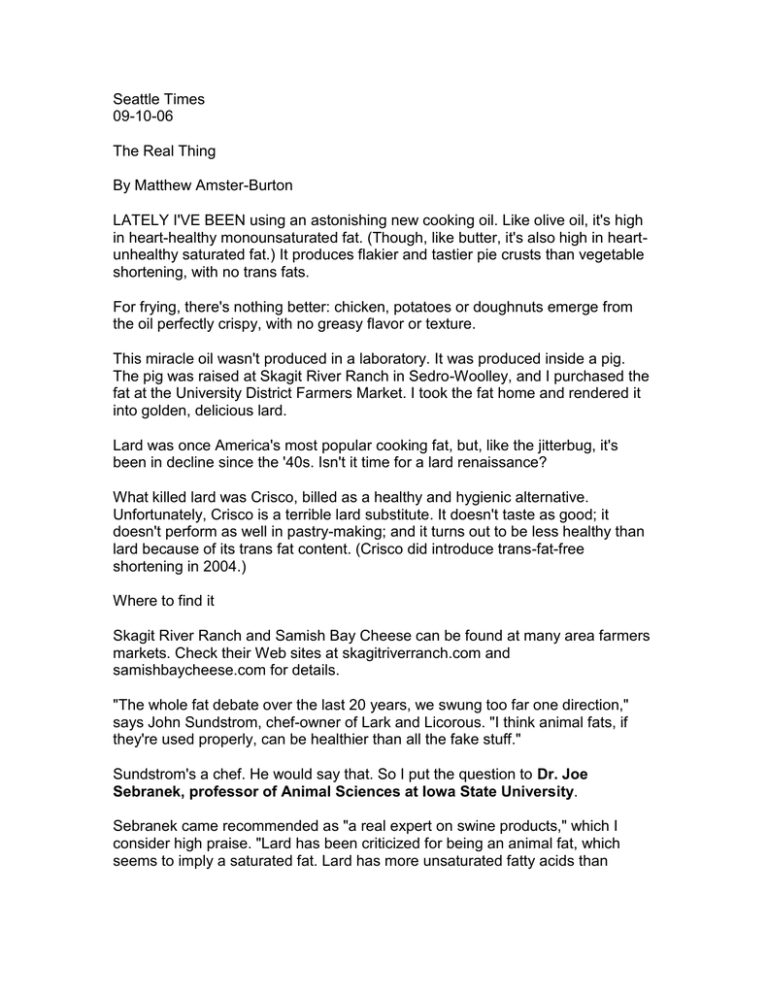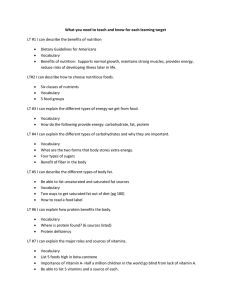Seattle Times 09-10-06 The Real Thing
advertisement

Seattle Times 09-10-06 The Real Thing By Matthew Amster-Burton LATELY I'VE BEEN using an astonishing new cooking oil. Like olive oil, it's high in heart-healthy monounsaturated fat. (Though, like butter, it's also high in heartunhealthy saturated fat.) It produces flakier and tastier pie crusts than vegetable shortening, with no trans fats. For frying, there's nothing better: chicken, potatoes or doughnuts emerge from the oil perfectly crispy, with no greasy flavor or texture. This miracle oil wasn't produced in a laboratory. It was produced inside a pig. The pig was raised at Skagit River Ranch in Sedro-Woolley, and I purchased the fat at the University District Farmers Market. I took the fat home and rendered it into golden, delicious lard. Lard was once America's most popular cooking fat, but, like the jitterbug, it's been in decline since the '40s. Isn't it time for a lard renaissance? What killed lard was Crisco, billed as a healthy and hygienic alternative. Unfortunately, Crisco is a terrible lard substitute. It doesn't taste as good; it doesn't perform as well in pastry-making; and it turns out to be less healthy than lard because of its trans fat content. (Crisco did introduce trans-fat-free shortening in 2004.) Where to find it Skagit River Ranch and Samish Bay Cheese can be found at many area farmers markets. Check their Web sites at skagitriverranch.com and samishbaycheese.com for details. "The whole fat debate over the last 20 years, we swung too far one direction," says John Sundstrom, chef-owner of Lark and Licorous. "I think animal fats, if they're used properly, can be healthier than all the fake stuff." Sundstrom's a chef. He would say that. So I put the question to Dr. Joe Sebranek, professor of Animal Sciences at Iowa State University. Sebranek came recommended as "a real expert on swine products," which I consider high praise. "Lard has been criticized for being an animal fat, which seems to imply a saturated fat. Lard has more unsaturated fatty acids than saturated, but most importantly, health issues are more greatly affected by total fat (and calorie) consumption than consumption of lard," Sebranek told me. Lard can be rendered from two kinds of pork fat: back fat or leaf (kidney) fat. Leaf lard, with its milder flavor and softer texture, is the best type for pie crust and pastry. Sundstrom swears by the stuff. "In the winter we've done a couple different styles of meat pie, where we'll do a very traditional English lard crust," he says. "We've used it for desserts as well. To do rhubarb-cherry crostata, it's amazing the difference between a lard crust and Crisco-and-butter." RECIPE Lardsnaps To find leaf fat, go to a farmers market. Skagit River Ranch and Samish Bay Cheese sell leaf fat at many local farmers markets. As you might expect, pork fat is not a major investment; $5 goes a long way. Once you get the fat, cut it into chunks and throw it into the food processor. Process it to a paste. Transfer the paste to an ovenproof pot and place it, uncovered, in a 250-degree oven. Leave it there for several hours, stirring occasionally, until you're left with lightly browned cracklings floating in a golden sea of lard. Let the lard cool a bit, then strain it through a paper towel-lined sieve into a clean container and refrigerate. It will keep for months. If you're ready to try cooking with lard but not rendering it at home, you can purchase prepared lard. Avoid the blue or green bricks sold at most supermarkets; it's partially hydrogenated like shortening, and the flavor can't compare to home-rendered. Every large Latin American grocery sells lard. Guadalupe Market in Burien (1111 S.W. 128th St., 206-901-1529) sells large tubs (around 2 pounds) for $3.49. In Bellevue, the upscale deli Porcella Urban Market (10245 Main St., Suite 101, 425-286-0080) sells 7 ounces of lard for $3.95. In both cases — and this will almost certainly be true of any lard you find for sale in Seattle — the lard is rendered from back fat. For frying, sautéing and making tamales or tortillas, this lard is ideal. But if you're determined to make the very best lard piecrust and don't want to render your own (or if this article has caused a run on leaf fat and the local vendors sell out), the best source I've found is Dietrich's Meats in Pennsylvania (610-756-6344). Their freshly rendered leaf lard is $2.50/pound. Shipping is about $10 for anything from one to five pounds, so go ahead and order five pounds, because the holidays are coming up, and fresh leaf lard (or a pie made with it) makes a great present. Well, possibly not such a great Hanukkah present. Matthew Amster-Burton is a Seattle freelance writer. Barry Wong is a Seattlebased freelance photographer. He can be reached at studio@barrywongphoto.com.




